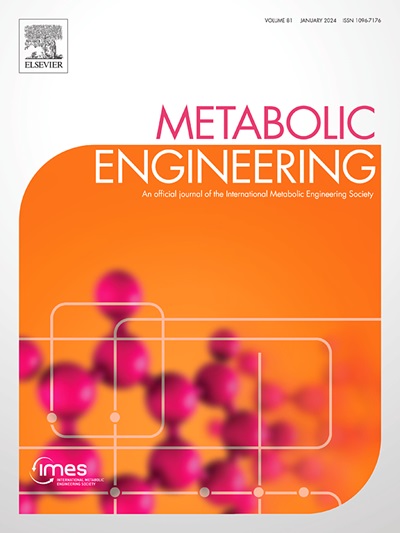设计一个基于生物传感器的高通量筛选平台,用于大肠杆菌高产咖啡酸的生产。
IF 6.8
1区 生物学
Q1 BIOTECHNOLOGY & APPLIED MICROBIOLOGY
引用次数: 0
摘要
咖啡酸(cafic acid, CA)是一种有价值的酚类化合物,在医药、食品添加剂和材料等方面有着广泛的应用。然而,其微生物生产面临着一些挑战,包括低外源酶活性和产品毒性。在这里,我们报道了一种集成的生物传感器驱动的高通量筛选(HTS)平台的开发,用于在大肠杆菌中高效生产CA。我们首先从woodii乙杆菌中鉴定并表征了一种新的酚酸反应转录因子CarR,并将其设计成对香豆酸(p-CA)生物传感器。系统优化p-CA生物传感器,减少背景,扩大动态范围,提高灵敏度。通过将这种生物传感器与荧光激活的细胞分选相结合,我们建立了一个高效的HTS平台,能够快速选择催化活性提高6.85倍的FjTALG85S突变体和对p-CA和CA耐受性增强的强大的p-CA产生菌株(M5)。随后对菌株CA8进行自下而上的代谢工程,在5-L生物反应器中获得了9.61 g L-1的CA滴度,这是迄今为止报道的最高滴度。我们的工作不仅克服了CA生物合成的关键瓶颈(低酪氨酸解氨酶活性,CA和对CA的细胞毒性),而且为加速微生物细胞工厂的工程生产对CA和其他衍生化学品提供了有力的工具。本文章由计算机程序翻译,如有差异,请以英文原文为准。
Engineering a biosensor based high-throughput screening platform for high-yield caffeic acid production in Escherichia coli.
Caffeic acid (CA) is a valuable phenolic compound with wide applications in pharmaceuticals, food additives, and materials. However, its microbial production faces several challenges, including low heterologous enzyme activity and product toxicity. Here, we report the development of an integrated biosensor-driven high-throughput screening (HTS) platform for the efficient production of CA in Escherichia coli. We first identified and characterized CarR, a novel phenolic acid-responsive transcription factor from Acetobacterium woodii, and engineered it into a p-coumaric acid (p-CA) biosensor. Systematic optimization of the p-CA biosensor, resulting in reduced background, extended dynamic range and increased sensitivity. By coupling this biosensor with fluorescence-activated cell sorting, we established an efficient HTS platform that enabled the rapid selection of an improved FjTALG85S mutant with a 6.85-fold enhancement in catalytic activity and a robust p-CA-producing strain (M5) with enhanced tolerance to p-CA and CA. Subsequent bottom-up metabolic engineering in strain CA8 achieved a CA titer of 9.61 g L-1 in a 5-L bioreactor, the highest reported titer to date. Our work not only overcomes key bottlenecks in CA biosynthesis (low tyrosine ammonia-lyase activity, CA and p-CA cytotoxicity) but also provides a powerful tool to accelerate the engineering of microbial cell factories for the production of p-CA and other derived chemicals.
求助全文
通过发布文献求助,成功后即可免费获取论文全文。
去求助
来源期刊

Metabolic engineering
工程技术-生物工程与应用微生物
CiteScore
15.60
自引率
6.00%
发文量
140
审稿时长
44 days
期刊介绍:
Metabolic Engineering (MBE) is a journal that focuses on publishing original research papers on the directed modulation of metabolic pathways for metabolite overproduction or the enhancement of cellular properties. It welcomes papers that describe the engineering of native pathways and the synthesis of heterologous pathways to convert microorganisms into microbial cell factories. The journal covers experimental, computational, and modeling approaches for understanding metabolic pathways and manipulating them through genetic, media, or environmental means. Effective exploration of metabolic pathways necessitates the use of molecular biology and biochemistry methods, as well as engineering techniques for modeling and data analysis. MBE serves as a platform for interdisciplinary research in fields such as biochemistry, molecular biology, applied microbiology, cellular physiology, cellular nutrition in health and disease, and biochemical engineering. The journal publishes various types of papers, including original research papers and review papers. It is indexed and abstracted in databases such as Scopus, Embase, EMBiology, Current Contents - Life Sciences and Clinical Medicine, Science Citation Index, PubMed/Medline, CAS and Biotechnology Citation Index.
 求助内容:
求助内容: 应助结果提醒方式:
应助结果提醒方式:


